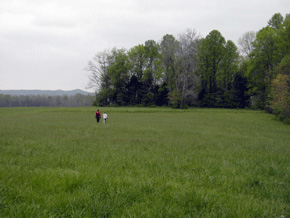FORT HILL,
PAINT VALLEY
CIRCULAR EARTHWORK
Below the southern prow of the earthwork, the park’s trails diverge. A piece of Ohio’s Buckeye Trail (a system that criss-crosses much of the state) heads south and opens out into a meadow, with a large barn.
To the right lies one of the ghostliest treasures in all of Ohio: visible on Google-Earth, and still here, at the edge of the meadow, is a beautifully preserved, ancient earthen ring. This is probably the best kept of the several hundred that were recorded during the 19th century.
It was partially excavated by Ohio Historical Society archaeologist Ray Baby (BAH-bee) in 1953. His exploratory trenches revealed a double ring of posts, 174 feet in diameter – he called it an “arbor”. A possible reconstruction, as well as details of Baby’s excavation work, is presented in the Fort Hill Museum. This ceremonial courtyard resembles circular “dancing floors” used in contemporary Indian rituals.
A few hundred feet to the southeast from the ring (though not visible today) is where Baby also found evidence of a large rectangular building, 120 feet long, with rounded corners. It suggests other known Hopewell-era Ceremonial Halls, like those at Liberty and Seip.
The prepared, two-thousand-year-old floor was littered with broken pottery, stone tools, and flint chips; pits were filled with the debris from flintknapping. The Museum’s reconstruction model shows a structural framework of buttressed tree-trunks, set in the ground, and covered with sheets of bark or skins.

In the park’s southern meadow stands the best preserved of Ohio’s small, ancient earthen rings.


